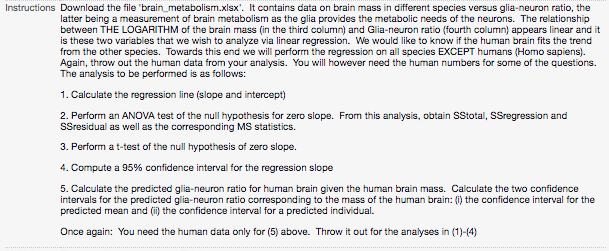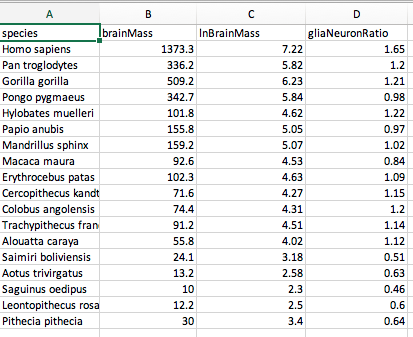A t-test would reject the null hypothesis at a 0.05 significance level. True or False?
A t-test would reject the null hypothesis at a 0.05 significance level. True or False?
MATLAB: An Introduction with Applications
6th Edition
ISBN:9781119256830
Author:Amos Gilat
Publisher:Amos Gilat
Chapter1: Starting With Matlab
Section: Chapter Questions
Problem 1P
Related questions
Topic Video
Question
A t-test would reject the null hypothesis at a 0.05 significance level.
True or False?

Transcribed Image Text:Instructions Download the file "brain_metabolism.xlsx'. It contains data on brain mass in different species versus glia-neuron ratio, the
latter being a measurement of brain metabolism as the glia provides the metabolic needs of the neurons. The relationship
between THE LOGARITHM of the brain mass (in the third column) and Glia-neuron ratio (fourth column) appears linear and it
is these two variables that we wish to analyze via linear regression. We would like to know if the human brain fits the trend
from the other species. Towards this end we will perform the regression on all species EXCEPT humans (Homo sapiens).
Again, throw out the human data from your analysis. You will however need the human numbers for some of the questions.
The analysis to be performed is as follows:
1. Calculate the regression line (slope and intercept)
2. Perform an ANOVA test of the null hypothesis for zero slope. From this analysis, obtain SStotal, SSregression and
SSresidual as well as the corresponding MS statistics.
3. Perform a t-test of the null hypothesis of zero slope.
4. Compute a 95% confidence interval for the regression slope
5. Calculate the predicted glia-neuron ratio for human brain given the human brain mass. Calculate the two confidence
intervals for the predicted glia-neuron ratio corresponding to the mass of the human brain: (i) the confidence interval for the
predicted mean and (ii) the confidence interval for a predicted individual.
Once again: You need the human data only for (5) above. Throw it out for the analyses in (1)-(4)

Transcribed Image Text:A
В
species
IbrainMass
InBrainMass
gliaNeuronRatio
Homo sapiens
1373.3
7.22
1.65
Pan troglodytes
336.2
5.82
1.2
Gorilla gorilla
509.2
6.23
1.21
Pongo pygmaeus
342.7
5.84
0.98
Hylobates muelleri
101.8
4.62
1.22
Papio anubis
155.8
5.05
0.97
Mandrillus sphinx
159.2
5.07
1.02
Macaca maura
92.6
4.53
0.84
Erythrocebus patas
Cercopithecus kandt
102.3
4.63
1.09
71.6
4.27
1.15
Colobus angolensis
Trachypithecus fran
Alouatta caraya
74.4
4.31
1.2
91.2
4.51
1.14
55.8
4.02
1.12
Saimiri boliviensis
24.1
3.18
0.51
Aotus trivirgatus
13.2
2.58
0.63
Saguinus oedipus
10
2.3
0.46
Leontopithecus rosa
12.2
2.5
0.6
Pithecia pithecia
30
3.4
0.64
Expert Solution
This question has been solved!
Explore an expertly crafted, step-by-step solution for a thorough understanding of key concepts.
This is a popular solution!
Trending now
This is a popular solution!
Step by step
Solved in 2 steps with 2 images

Knowledge Booster
Learn more about
Need a deep-dive on the concept behind this application? Look no further. Learn more about this topic, statistics and related others by exploring similar questions and additional content below.Recommended textbooks for you

MATLAB: An Introduction with Applications
Statistics
ISBN:
9781119256830
Author:
Amos Gilat
Publisher:
John Wiley & Sons Inc

Probability and Statistics for Engineering and th…
Statistics
ISBN:
9781305251809
Author:
Jay L. Devore
Publisher:
Cengage Learning

Statistics for The Behavioral Sciences (MindTap C…
Statistics
ISBN:
9781305504912
Author:
Frederick J Gravetter, Larry B. Wallnau
Publisher:
Cengage Learning

MATLAB: An Introduction with Applications
Statistics
ISBN:
9781119256830
Author:
Amos Gilat
Publisher:
John Wiley & Sons Inc

Probability and Statistics for Engineering and th…
Statistics
ISBN:
9781305251809
Author:
Jay L. Devore
Publisher:
Cengage Learning

Statistics for The Behavioral Sciences (MindTap C…
Statistics
ISBN:
9781305504912
Author:
Frederick J Gravetter, Larry B. Wallnau
Publisher:
Cengage Learning

Elementary Statistics: Picturing the World (7th E…
Statistics
ISBN:
9780134683416
Author:
Ron Larson, Betsy Farber
Publisher:
PEARSON

The Basic Practice of Statistics
Statistics
ISBN:
9781319042578
Author:
David S. Moore, William I. Notz, Michael A. Fligner
Publisher:
W. H. Freeman

Introduction to the Practice of Statistics
Statistics
ISBN:
9781319013387
Author:
David S. Moore, George P. McCabe, Bruce A. Craig
Publisher:
W. H. Freeman